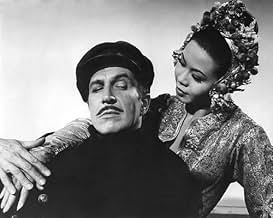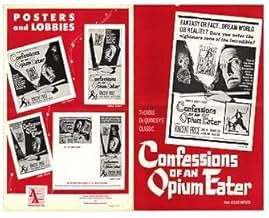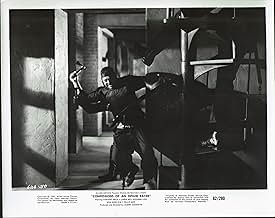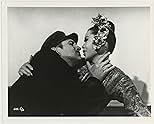Ajouter une intrigue dans votre langueIn 19th-century San Francisco's Chinatown, American adventurer Gilbert De Quincey saves slave girls owned by the Chinese Tong factions.In 19th-century San Francisco's Chinatown, American adventurer Gilbert De Quincey saves slave girls owned by the Chinese Tong factions.In 19th-century San Francisco's Chinatown, American adventurer Gilbert De Quincey saves slave girls owned by the Chinese Tong factions.
- Lotus
- (as June Kim)
- Lo Tsen
- (as Caroline Kido)
- First Dancing Girl
- (as Joanne Miya)
- Auctionieer
- (as John Mamo)
Avis en vedette
Albert Zugsmith, better known as the producer of Orson Welles' "Touch of Evil", produced and directed "Opium Eater", a black and white b-grader hastily dismissed by reviewers. It has genuine merit to those who like offbeat cinema. Although it uses Thomas De Quincey's 1821 book title, (actually called "Confessions of an English Opium Eater") it conjures up its own story of deception and murder. Price as Gilbert De Quincey, who also narrates the film, suggests he is an ancestor. "Opium Eater" actually has more in common with the Fu Manchu mysteries or the yellow peril pulps popular in the 1930s. Add to this its fortune cookie dialogue and ramblings about dreams, reality, death and destiny and you have one very strange movie indeed. There is no doubt "Opium Eater" is bizarre, but it is also literate and genuinely mysterious.
Albert Glasser's spooky soundtrack is one of the films great strengths. His eerie electronic score endows it with an ambience of unease and dislocation. In one scene, after Price awakens from his opium-induced nightmare, axe-wielding henchmen chase him across rooftops. Here the music drops right off the soundtrack and we are left with only an unnerving silence. Zugsmith's direction is clumsy at times but many intriguing moments make up for this, including his creative use of slow motion and the nightmare montage in the joss house. This drug scene must have been quite controversial in 1962 and I wonder if it was snipped from certain prints or caused the film to be banned in some areas.
The love/hate relationship between De Quincey and Ruby Low suggests their fate is predetermined and leads to a quite unexpected, but oddly satisfying outcome.
It's a flawed film, but remains a curious, haunting experience deserving of a cult following. >
Price's De Quincy is a sailor, whose voice over is a Raymond Chandler meets De Quincy poetry, come to San Francisco after a long stay in "the orient", where he involves himself in the dubious world of human trafficking, particularly brides in China Town during the 1800's Tong Gang Wars. The film opens with a brutal scene involving screaming women thrown in a net like freshly caught tuna, and then a violent battle between two gangs on the beach as they try to deliver the kidnapped women to their fate.
Albert Zugsmith produced classics like "The Incredible Shrinking Man", "Written On The Wind", and "Touch Of Evil", along with directing many exploitation flicks, which this film veers into from time to time. The film is more in the Siejun Suzuki brand of wildly inventive, free wheeling pulpy expressionism, than Ed Wood kitschy ineptness. Despite the title the only scene involving opium is when Price takes some in order to get close to the women trafficking ring, and has a particularly impressive Lynchian circa Elephant-Man era hallucination scene (which is worth price of admission alone).
However the best scene comes when Price wakes up surrounded by guards and has to make a slow motion (cus he's high on opium) dash out of the den, and to the rooftops of china town. The scene is also completely silent, and truly marvelous in it's execution. I know slow motion action sequences where Greogiran chanting plays over sweat glistened A-listers shooting each other in mid air are common place now, but in Zugsmith's hands your reminded of excting an action sequence can be when it's done right. The plot is not particularly strong.
Why De Quincy is saving the girl, or what he is doing in China town at all, has many twists and turns, and leaves some gaps to be filled? But the direction, the suspense, and especially Price's performance make lines that would sound preposterous and almost Terrance Malick like in their stream of consciousness like "You wear as many masks as their are stars reflected in a gutter", sound as if he says them everyday. Such are the gifts of Price.
I was very pleased with this movie, that can be found easily on Youtube, though you might want to get a good copy to take in the fullness of Zugsmith's frames.There is a dreaminess and nightmarishness to all of the scenes, like opium was poured over a script to a lesser film, and this movie stumbled out of a smoke ridden room, rambling of dancing girls emerging from cages, crashes through windows, being swept to sea from sewer drains, and teetering on the edge of rooftops with vertigo at a snails pace, and feeling "the abbacus of fate has your number". Good times.
Ah, 1962. Producer/director Albert Zugsmith evidently met his Muse and cranked out this gleefully un-PC look at the Yellow Peril in San Francisco 1902. Zugsmith, despite some legitimate credits on his resume, wallowed in exploitation for the most part. COAOE somehow escaped Zugsmith's penchant for low-level production and rose above what should have been a Z-list production. What resulted was a real oddity, a bastardized version of Thomas De Quincey's late 1800s drug tale. This movie bears little resemblance to De Quincey's fable. The screenplay is more Sax Rohmer/Fu Manchu than anything else.
This drive-in classic has it all folks. Enigmatic fortune cookie wisdom, secret passages out the yin-yang, a sultry Dragon Lady named Ruby with world domination on her mind, a wisecracking Chinese Munchkin sing-song girl, Polynesian twerking, firecrackers, Tong warfare, every Chinese actor in Hollywood, Vincent Price as a moody poetic sort of action hero...and yes, opium. Price's opium dream is a real hoot for fans of late 1950s Allied Artists horror/sci-fi flicks. After nodding off on the pipe, Vinny gets visited by a host of critters from other AA pics in short cameo appearances. He sees the "eyeball hand" from Invasion of the Saucermen, crawling along. He sees the monster tarantula from The Spider. He sees the "voodoo woman" from Voodoo Woman. He sees the skull from Screaming Skull. Also lots of Chinese masks and fish-eye lens howling people. Zugsmith really raided the AA vaults to put this trip together.
The famous slo-mo scene, done in complete silence, is still pretty effective. It's surreal, dreamy, and unexpected. Also of note is the "girl auction" in which captive gals from the United Nations perform native dances for the Mandarin crowd and their impressive wisdom hats. Watch for Miss Polynesia, who really does twerk, in addition to writhing around to a soundtrack that switches from ersatz Chinese to SF North Beach beatnik coffee bar free form jazz. Tasty!
Well worth seeking out if you've heard about this. It's short and to the point. Also extremely weird. The ending is unexpected. Over fifty years later, a movie like this could not be made. There are racial stereotypes presented in an unapologetic manner, strictly due to the time in which it was made.
Anyway, how can you resist a movie that owns the line: "NO! Use the velvet whips, they don't mar the body!" Delicious.
An adventurer (Vincent Price) in 19th century San Francisco becomes involved with Tong wars, slave auctions of Chinese girls and opium dens.
This is one of the most bizarre films I have ever seen. Even more jaw dropping that it got made in 1962. It is exploitation madness at it's best. Price however brings his great talent and class to make this a cut above other strange films made in the 1960s. All the Asian roles are played by real Asians such as busy character actors like Richard Loo and Philip Ahn. Linda Ho plays an evil "Mata Hari" type. She is deliciously nasty and smolderingly sexy in this part, probably the best role she ever had in her short film career. When Price settles down with a pipe in an opium den, there is a incredible druggy fight sequence all done in slow motion, it has to be seen to be believed. Another highlight is a wisecracking female Chinese dwarf (Alicia Li) who provides some wickedly funny quips. It ends with an auction scene where girls are sold for opium. They do some suggestive dances which most have seemed scandalous at the time. Price fans and anyone interested in something weird should seek this out.
Le saviez-vous
- AnecdotesIndirectly led to the creation of the famed East West Players. Many of the Asian actors, including a young James Hong, were incensed after the only roles they were offered were "opium dope people and the prostitutes and so forth." After a petition to producer Albert Zugsmith fell on deaf ears, Hong co-founded the East West Players to give Asian-American actors more meaningful, non-stereotypical roles.
- GaffesThis film takes place in the 19th century, as stated, and seen in the townspeople's dress. But in the beach scene, a Thompson machine gun is used; this wasn't available until after 1918.
- Citations
Gilbert De Quincey: [narration] When the dreams of the dark, idle, monstrous phenomenae move forever forward... wild, barbarous, capricious into the great yawning darkness... to be fixed for centuries in secret rooms. De Quincey, the artist? De Quincey, the pagan priest, to be worshipped, to be sacrificed. What is a dream and what is reality? Sometimes a man's life can be a nightmare; other times, cannot a nightmare be life? And the voices that I heard, were they the voices of some strange imitation of men in some strange, writhing jungle of my imagination? Was this opium or was it reality? Was I dead? Or I was I only beginning to live?
- ConnexionsEdited from Voodoo Woman (1957)
Meilleurs choix
- How long is Confessions of an Opium Eater?Propulsé par Alexa
Détails
- Durée1 heure 25 minutes
- Couleur
- Rapport de forme
- 1.37 : 1
Contribuer à cette page































